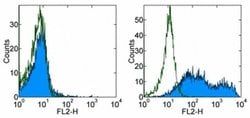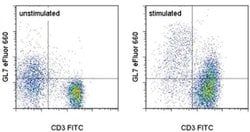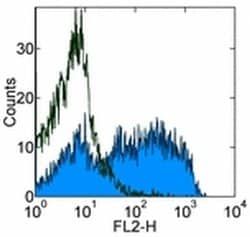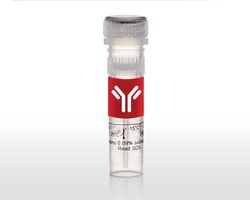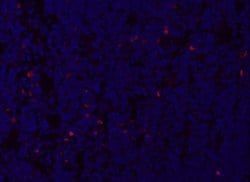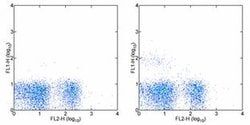50-133-15
GL7 Monoclonal Antibody (GL-7 (GL7)), eBioscience™, Invitrogen™
Manufacturer: Fischer Scientific
Select a Size
| Pack Size | SKU | Availability | Price |
|---|---|---|---|
| Each of 1 | 50-133-15-Each-of-1 | In Stock | ₹ 11,303.00 |
50-133-15 - Each of 1
In Stock
Quantity
1
Base Price: ₹ 11,303.00
GST (18%): ₹ 2,034.54
Total Price: ₹ 13,337.54
Antigen
GL7
Classification
Monoclonal
Concentration
0.5 mg/mL
Formulation
PBS with 0.09% sodium azide; pH 7.2
Host Species
Rat
Quantity
100 μg
Primary or Secondary
Primary
Content And Storage
4° C
Form
Liquid
Applications
Flow Cytometry, Immunohistochemistry (Frozen), Immunoprecipitation
Clone
GL-7 (GL7)
Conjugate
Unconjugated
Gene Alias
GL7 antigen; Ly77; Ly-77
Purification Method
Affinity chromatography
Regulatory Status
RUO
Target Species
Human, Mouse
Product Type
Antibody
Isotype
IgM
Related Products
Description
- Description: This GL7 monoclonal antibody reacts with a cell-surface protein found on T and B lymphocytes activated in vitro, on bone marrow pre-B-II cells, germinal center B cells, and also human B cell lines Ramos and Daudi
- There is strain variability with respect to antigen distribution on thymocytes and Con A-activated spleen cells, with expression in BALB/c greater than that in C57BL/6
- GL7 is commonly used as a marker for mouse germinal center B cells
- The epitope of GL7 has been identified as a sialic acid glycan moiety called Neu5Ac
- This moiety is recognized by CD22
- Applications Reported: The GL-7 (GL7) antibody has been reported for use in flow cytometric analysis, immunoprecipitation, and immunohistochemical staining of frozen tissue sections
- Applications Tested: The GL-7 (GL7) antibody has been tested by flow cytometric analysis of Con A-stimulated mouse splenocytes
- This can be used at less than or equal to 0.5 μg per test
- A test is defined as the amount (μg) of antibody that will stain a cell sample in a final volume of 100 μL
- Cell number should be determined empirically but can range from 10^5 to 10^8 cells/test
- It is recommended that the antibody be carefully titrated for optimal performance in the assay of interest
- Purity: Greater than 90%, as determined by SDS-PAGE
- Aggregation: Less than 10%, as determined by HPLC
- Filtration: 0.2 μm post-manufacturing filtered
- GL7 is a cell-surface protein found on T and B lymphocytes activated in vitro, on bone marrow pre-B-II cells, germinal center B cells, and also human B cell lines Ramos and Daudi
- There is strain variability with respect to antigen distribution on thymocytes and Con A-activated spleen cells, with expression in BALB/c greater than that in C57BL/6
- GL7 is commonly used as a marker for mouse germinal center B cells
- The epitope of GL7 has been identified as a sialic acid glycan moiety called Neu5Ac
- This moiety is recognized by CD22.
Compare Similar Items
Show Difference
Antigen: GL7
Classification: Monoclonal
Concentration: 0.5 mg/mL
Formulation: PBS with 0.09% sodium azide; pH 7.2
Host Species: Rat
Quantity: 100 μg
Primary or Secondary: Primary
Content And Storage: 4° C
Form: Liquid
Applications: Flow Cytometry, Immunohistochemistry (Frozen), Immunoprecipitation
Clone: GL-7 (GL7)
Conjugate: Unconjugated
Gene Alias: GL7 antigen; Ly77; Ly-77
Purification Method: Affinity chromatography
Regulatory Status: RUO
Target Species: Human, Mouse
Product Type: Antibody
Isotype: IgM
Antigen:
GL7
Classification:
Monoclonal
Concentration:
0.5 mg/mL
Formulation:
PBS with 0.09% sodium azide; pH 7.2
Host Species:
Rat
Quantity:
100 μg
Primary or Secondary:
Primary
Content And Storage:
4° C
Form:
Liquid
Applications:
Flow Cytometry, Immunohistochemistry (Frozen), Immunoprecipitation
Clone:
GL-7 (GL7)
Conjugate:
Unconjugated
Gene Alias:
GL7 antigen; Ly77; Ly-77
Purification Method:
Affinity chromatography
Regulatory Status:
RUO
Target Species:
Human, Mouse
Product Type:
Antibody
Isotype:
IgM
Antigen: GL7
Classification: Monoclonal
Concentration: 0.5 mg/mL
Formulation: PBS with 0.09% sodium azide; pH 7.2
Host Species: Rat
Quantity: 500 μg
Primary or Secondary: Primary
Content And Storage: 4° C
Form: Liquid
Applications: Flow Cytometry, Immunohistochemistry (Frozen), Immunoprecipitation
Clone: GL-7 (GL7)
Conjugate: Unconjugated
Gene Alias: GL7 antigen; Ly77; Ly-77
Purification Method: Affinity chromatography
Regulatory Status: RUO
Target Species: Human, Mouse
Product Type: Antibody
Isotype: IgM
Antigen:
GL7
Classification:
Monoclonal
Concentration:
0.5 mg/mL
Formulation:
PBS with 0.09% sodium azide; pH 7.2
Host Species:
Rat
Quantity:
500 μg
Primary or Secondary:
Primary
Content And Storage:
4° C
Form:
Liquid
Applications:
Flow Cytometry, Immunohistochemistry (Frozen), Immunoprecipitation
Clone:
GL-7 (GL7)
Conjugate:
Unconjugated
Gene Alias:
GL7 antigen; Ly77; Ly-77
Purification Method:
Affinity chromatography
Regulatory Status:
RUO
Target Species:
Human, Mouse
Product Type:
Antibody
Isotype:
IgM
Antigen: AIRE
Classification: Monoclonal
Concentration: 0.5 mg/mL
Formulation: PBS with 0.09% sodium azide; pH 7.2
Host Species: Rat
Quantity: 100 μg
Primary or Secondary: Primary
Content And Storage: 4° C
Form: Liquid
Applications: Flow Cytometry, Immunocytochemistry, Immunohistochemistry (Frozen), Immunoprecipitation, Western Blot
Clone: 5H12
Conjugate: Unconjugated
Gene Alias: Aire; AIRE protein; AIRE1; APECED; APECED protein; APECED protein homolog; APS1; APSI; Autoimmune polyendocrinopathy candidiasis ectodermal dystrophy protein; autoimmune polyendocrinopathy candidiasis ectodermal dystrophy protein homolog; Autoimmune regulator; autoimmune regulator (autoimmune polyendocrinopathy candidiasis ectodermal dystrophy); autoimmune regulator AIRE1a; LOW QUALITY PROTEIN: autoimmune regulator; OTTHUMP00000109529; PGA1
Purification Method: Affinity chromatography
Regulatory Status: RUO
Target Species: Mouse
Product Type: Antibody
Isotype: IgG2c κ
Antigen:
AIRE
Classification:
Monoclonal
Concentration:
0.5 mg/mL
Formulation:
PBS with 0.09% sodium azide; pH 7.2
Host Species:
Rat
Quantity:
100 μg
Primary or Secondary:
Primary
Content And Storage:
4° C
Form:
Liquid
Applications:
Flow Cytometry, Immunocytochemistry, Immunohistochemistry (Frozen), Immunoprecipitation, Western Blot
Clone:
5H12
Conjugate:
Unconjugated
Gene Alias:
Aire; AIRE protein; AIRE1; APECED; APECED protein; APECED protein homolog; APS1; APSI; Autoimmune polyendocrinopathy candidiasis ectodermal dystrophy protein; autoimmune polyendocrinopathy candidiasis ectodermal dystrophy protein homolog; Autoimmune regulator; autoimmune regulator (autoimmune polyendocrinopathy candidiasis ectodermal dystrophy); autoimmune regulator AIRE1a; LOW QUALITY PROTEIN: autoimmune regulator; OTTHUMP00000109529; PGA1
Purification Method:
Affinity chromatography
Regulatory Status:
RUO
Target Species:
Mouse
Product Type:
Antibody
Isotype:
IgG2c κ
Antigen: NK1.1
Classification: Monoclonal
Concentration: 0.5 mg/mL
Formulation: PBS with 0.09% sodium azide; pH 7.2
Host Species: Mouse
Quantity: 100 μg
Primary or Secondary: Primary
Content And Storage: 4° C
Form: Liquid
Applications: Flow Cytometry, Immunoprecipitation
Clone: PK136
Conjugate: Unconjugated
Gene Alias: AI462337; CD161; CD161 antigen-like family member B; CD161 antigen-like family member C; CD161b; CD161c; EMBL:AAQ11375.1}; Inhibitory receptor NKR-P1B; killer cell lectin-like receptor subfamily A member 1C; killer cell lectin-like receptor subfamily B member 1B; killer cell lectin-like receptor subfamily B member 1B allele A; Killer cell lectin-like receptor subfamily B member 1B allele B; killer cell lectin-like receptor subfamily B member 1B allele C; killer cell lectin-like receptor subfamily B member 1C; killer cell lectin-like receptor subfamily B member 1D; killer cell lectin-like receptor subfamily B member 1F; KLRB1; Klrb1b; klrb1b {ECO:0000312; Klrb1c; Klrb1d; Klrb1f; klrb1f {ECO:0000250; Ly55; Ly-55; Ly55b; ly-55b; Ly55c; ly-55c; Ly55d; Ly-55d; Ly59; Ly-59; lymphocyte antigen 55 complex, locus B; lymphocyte antigen 55 complex, locus C; lymphocyte antigen 55 complex, locus D; lymphocyte antigen 55b; lymphocyte antigen 55c; Lymphocyte antigen 55d; lymphocyte antigen 59; MGC163757; MGC163759; natural killer cell receptor protein NKR-P1B; natural killer cell receptor protein NKR-P1C; natural killer cell receptor-P1; natural killer cell surface protein NKR-P1B allele B6; Natural killer cell surface protein NKR-P1B allele RNK/SD/BN/F344; natural killer cell surface protein NKR-P1B allele SJL/BALB; natural killer cell surface protein NKR-P1B allele TO; natural killer cell surface protein NKR-P1F; Natural killer cell surface protein P1-40; natural killer cell-associated antigen 1; natural killer cells; nk cells; Nk1; Nk-1; NK1.1; Nk1.2; Nk-1.2; NKRP1; NK-RP1; NKR-P1 34; NKR-P1 40; NKR-P1.9; NKRP140; Nkrp1b; NKR-P1B; Nkrp1-b; NKR-P1B protein; Nkrp1c; NKR-P1C; Nkrp1d; NKR-P1D; Nkrp1f; NKR-P1F; RGD:2975}; UniProtKB:Q8VD98}
Purification Method: Affinity chromatography
Regulatory Status: RUO
Target Species: Mouse
Product Type: Antibody
Isotype: IgG2a κ
Antigen:
NK1.1
Classification:
Monoclonal
Concentration:
0.5 mg/mL
Formulation:
PBS with 0.09% sodium azide; pH 7.2
Host Species:
Mouse
Quantity:
100 μg
Primary or Secondary:
Primary
Content And Storage:
4° C
Form:
Liquid
Applications:
Flow Cytometry, Immunoprecipitation
Clone:
PK136
Conjugate:
Unconjugated
Gene Alias:
AI462337; CD161; CD161 antigen-like family member B; CD161 antigen-like family member C; CD161b; CD161c; EMBL:AAQ11375.1}; Inhibitory receptor NKR-P1B; killer cell lectin-like receptor subfamily A member 1C; killer cell lectin-like receptor subfamily B member 1B; killer cell lectin-like receptor subfamily B member 1B allele A; Killer cell lectin-like receptor subfamily B member 1B allele B; killer cell lectin-like receptor subfamily B member 1B allele C; killer cell lectin-like receptor subfamily B member 1C; killer cell lectin-like receptor subfamily B member 1D; killer cell lectin-like receptor subfamily B member 1F; KLRB1; Klrb1b; klrb1b {ECO:0000312; Klrb1c; Klrb1d; Klrb1f; klrb1f {ECO:0000250; Ly55; Ly-55; Ly55b; ly-55b; Ly55c; ly-55c; Ly55d; Ly-55d; Ly59; Ly-59; lymphocyte antigen 55 complex, locus B; lymphocyte antigen 55 complex, locus C; lymphocyte antigen 55 complex, locus D; lymphocyte antigen 55b; lymphocyte antigen 55c; Lymphocyte antigen 55d; lymphocyte antigen 59; MGC163757; MGC163759; natural killer cell receptor protein NKR-P1B; natural killer cell receptor protein NKR-P1C; natural killer cell receptor-P1; natural killer cell surface protein NKR-P1B allele B6; Natural killer cell surface protein NKR-P1B allele RNK/SD/BN/F344; natural killer cell surface protein NKR-P1B allele SJL/BALB; natural killer cell surface protein NKR-P1B allele TO; natural killer cell surface protein NKR-P1F; Natural killer cell surface protein P1-40; natural killer cell-associated antigen 1; natural killer cells; nk cells; Nk1; Nk-1; NK1.1; Nk1.2; Nk-1.2; NKRP1; NK-RP1; NKR-P1 34; NKR-P1 40; NKR-P1.9; NKRP140; Nkrp1b; NKR-P1B; Nkrp1-b; NKR-P1B protein; Nkrp1c; NKR-P1C; Nkrp1d; NKR-P1D; Nkrp1f; NKR-P1F; RGD:2975}; UniProtKB:Q8VD98}
Purification Method:
Affinity chromatography
Regulatory Status:
RUO
Target Species:
Mouse
Product Type:
Antibody
Isotype:
IgG2a κ
